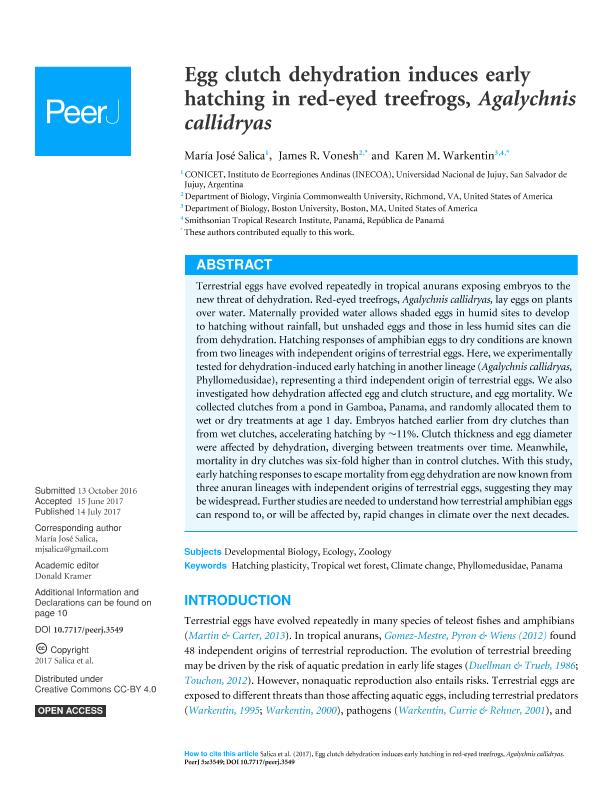Artículo
Egg clutch dehydration induces early hatching in red-eyed treefrogs, Agalychnis callidryas
Fecha de publicación:
07/2017
Editorial:
PeerJ
Revista:
PeerJ
ISSN:
2376-5992
Idioma:
Inglés
Tipo de recurso:
Artículo publicado
Clasificación temática:
Resumen
Terrestrial eggs have evolved repeatedly in tropical anurans exposing embryos to the new threat of dehydration. Red-eyed treefrogs, Agalychnis callidryas, lay eggs on plants over water. Maternally provided water allows shaded eggs in humid sites to develop to hatching without rainfall, but unshaded eggs and those in less humid sites can die from dehydration. Hatching responses of amphibian eggs to dry conditions are known from two lineages with independent origins of terrestrial eggs. Here, we experimentally tested for dehydration-induced early hatching in another lineage (Agalychnis callidryas, Phyllomedusidae), representing a third independent origin of terrestrial eggs. We also investigated how dehydration affected egg and clutch structure, and egg mortality. We collected clutches from a pond in Gamboa, Panama, and randomly allocated them to wet or dry treatments at age 1 day. Embryos hatched earlier from dry clutches than from wet clutches, accelerating hatching by ∼11%. Clutch thickness and egg diameter were affected by dehydration, diverging between treatments over time. Meanwhile, mortality in dry clutches was six-fold higher than in control clutches. With this study, early hatching responses to escape mortality from egg dehydration are now known from three anuran lineages with independent origins of terrestrial eggs, suggesting they may be widespread. Further studies are needed to understand how terrestrial amphibian eggs can respond to, or will be affected by, rapid changes in climate over the next decades.
Archivos asociados
Licencia
Identificadores
Colecciones
Articulos(INECOA)
Articulos de INSTITUTO DE ECORREGIONES ANDINAS
Articulos de INSTITUTO DE ECORREGIONES ANDINAS
Citación
Salica, María José; Vonesh, James R.; Warkentin, Karen M.; Egg clutch dehydration induces early hatching in red-eyed treefrogs, Agalychnis callidryas; PeerJ; PeerJ; 5; 7-2017; 1-13; e3549
Compartir
Altmétricas




